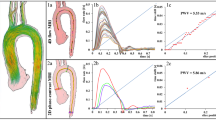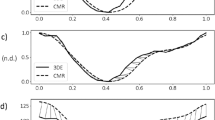Abstract
The analysis of anatomical and hemodynamic vessel parameters plays an important role in diagnosis and therapy planning for aortic diseases. Normal values and decision thresholds are usually based on global or local parameters provided by population studies. In order to enable a more holistic comparison of a single subject and a matching reference population we have developed a spatiotemporal normalization concept for the analysis of 4D PC MRI data of the thoracic aorta. This enables the comparison of geometric properties and pressure differences along the vessel course as well as in a sector model, which represents a cross-sectional value distribution. We tested the applicability of the presented approach by comparing subjects with aortic diseases to matching subgroups of a normal reference population. The presented framework enabled a visual and quantitative assessment of the local geometric and pressure distribution changes of different pathological alterations of the aorta. It will be extended to integrate further hemodynamic properties and larger reference cohorts to support clinical decision making based on hemodynamic information in near future.
Access this chapter
Tax calculation will be finalised at checkout
Purchases are for personal use only
Similar content being viewed by others
References
ESC Committee for Practice Guidelines: 2014 ESC Guidelines on the diagnosis and treatment of aortic diseases. Eur. Heart J. 35(41), 2873–2926 (2014). https://doi.org/10.1093/eurheartj/ehu281. Epub 29 Aug 2014
Rylski, B., Desjardins, B., Moser, W., Bavaria, J.E., Milewski, R.K.: Gender-related changes in aortic geometry throughout life. Eur. J. Cardiothorac. Surg. 45(5), 805–811 (2014). https://doi.org/10.1093/ejcts/ezt597
Redheuil, A., et al.: Age-related changes in aortic arch geometry: relationship with proximal aortic function and left ventricular mass and remodeling. J. Am. Coll. Cardiol. 58(12), 1262–1270 (2011)
Garcia, J., et al.: Distribution of blood flow velocity in the normal aorta: effect of age and gender. J. Magn. Reson. Imaging 47(2), 487–498 (2018)
Harloff, A., et al.: Determination of aortic stiffness using 4D flow cardiovascular magnetic resonance - a population-based study. J. Cardiovasc. Magn. Reson. 20(1), 43 (2018)
Mistelbauer, G., Schmidt, J., Sailer, A., Bäumler, K., Walters, S., Fleischmann, D.: Aortic dissection maps: comprehensive visualization of aortic dissections for risk assessment. In: VCBM (2016)
Behrendt, B., Ebel, S., Gutberlet, M., Preim, B.: A framework for visual comparison of 4D PC-MRI aortic blood flow data. In: VCBM (2018)
Lamata, P., et al.: Aortic relative pressure components derived from four-dimensional flow cardiovascular magnetic resonance. Magn. Reson. Med. 72, 1162–1169 (2014)
Bock, J., et al.: In vivo non-invasive 4D pressure difference mapping in the human aorta: phantom comparison and application in healthy volunteers and patients. Magn. Reson. Med. 66(4), 1079–1088 (2011)
Ebbers, T., Wigstrom, L., Bolger, A.F., Engvall, J., Karlsson, M.: Estimation of relative cardiovascular pressures using time-resolved three-dimensional phase contrast MRI. Magn. Reson. Med. 45(5), 872–879 (2001)
Tyszka, J.M., Laidlaw, D.H., Asa, J.W., Silverman, J.M.: Three-dimensional, time-resolved (4D) relative pressure mapping using magnetic resonance imaging. J. Magn. Reson. Imaging 12(2), 321–329 (2000)
Hennemuth, A., et al.: Fast interactive exploration of 4D MRI flow data. In: Wong, K.H., et al. (eds.) SPIE Medical Imaging, vol. 7964, 79640E, pp. 1–11. SPIE (2011)
Meier, S., Hennemuth, A., Drexl, J., Bock, J., Jung, B., Preusser, T.: A fast and noise-robust method for computation of intravascular pressure difference maps from 4D PC-MRI data. In: Camara, O., Mansi, T., Pop, M., Rhode, K., Sermesant, M., Young, A. (eds.) STACOM 2012. LNCS, vol. 7746, pp. 215–224. Springer, Heidelberg (2013). https://doi.org/10.1007/978-3-642-36961-2_25
Riesenkampff, E., et al.: Pressure fields by flow-sensitive, 4D, velocity-encoded CMR in patients with aortic coarctation. JACC Cardiovasc. Imaging 7(9), 920–926 (2014)
Mirzaee, H., et al.: MRI-based computational hemodynamics in patients with aortic coarctation using the lattice Boltzmann methods: clinical validation study. J. Magn. Reson. Imaging 45, 139–146 (2017). https://doi.org/10.1002/jmri.25366
Stalder, A., Russe, M., Frydrychowicz, A., Bock, J., Hennig, J., Markl, M.: Quantitative 2D and 3D phase contrast MRI: optimized analysis of blood flow and vessel wall parameters. Magn. Reson. Med. 60, 1218–1231 (2008)
Liu, J., Shar, J.A., Sucosky, P.: Wall shear stress directional abnormalities in BAV aortas: toward a new hemodynamic predictor of aortopathy? Front Physiol. 14(9), 993 (2018)
Author information
Authors and Affiliations
Corresponding author
Editor information
Editors and Affiliations
Rights and permissions
Copyright information
© 2019 Springer Nature Switzerland AG
About this paper
Cite this paper
Karimkeshteh, S., Kaufhold, L., Nordmeyer, S., Jarmatz, L., Harloff, A., Hennemuth, A. (2019). Comparing Subjects with Reference Populations - A Visualization Toolkit for the Analysis of Aortic Anatomy and Pressure Distribution. In: Coudière, Y., Ozenne, V., Vigmond, E., Zemzemi, N. (eds) Functional Imaging and Modeling of the Heart. FIMH 2019. Lecture Notes in Computer Science(), vol 11504. Springer, Cham. https://doi.org/10.1007/978-3-030-21949-9_40
Download citation
DOI: https://doi.org/10.1007/978-3-030-21949-9_40
Published:
Publisher Name: Springer, Cham
Print ISBN: 978-3-030-21948-2
Online ISBN: 978-3-030-21949-9
eBook Packages: Computer ScienceComputer Science (R0)




